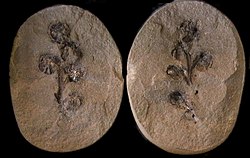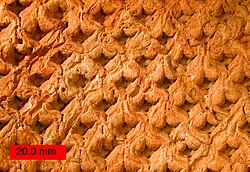This article needs additional citations for verification .(October 2011) |

| Part of a series on |
| Paleontology |
|---|
 |
Paleobotany or palaeobotany, also known as paleophytology, is the branch of botany dealing with the recovery and identification of plant fossils from geological contexts, and their use for the biological reconstruction of past environments (paleogeography), and the evolutionary history of plants, with a bearing upon the evolution of life in general. It is a component of paleontology and paleobiology. The prefix palaeo- or paleo- means "ancient, old", [1] and is derived from the Greek adjective παλαιός, palaios. [2] Paleobotany includes the study of land plants, as well as the study of prehistoric marine photoautotrophs such as photosynthetic algae, seaweeds or kelp. A closely related field is palynology, which is the study of fossilized and extant spores and pollen.
Contents
- Related Sciences
- Paleoecology
- Paleopalynology
- Overview of the paleobotanical record
- Plant fossils
- Preservation of plant fossils
- Fossil-taxa
- Fossil groups of plants
- Notable paleobotanists
- See also
- References
- Further reading
- External links
Paleobotany is important in the reconstruction of ancient ecological and climate systems, known as paleoecology and paleoclimatology respectively. It is fundamental to the study of green plant development and evolution. Paleobotany is a historical science much like its adjacent, paleontology. Because of the understanding that paleobotany gives to archeologists, it has become important to the field of archaeology as a whole. primarily for the use of phytoliths in relative dating and in paleoethnobotany. [3]
The study and discipline of paleobotany have been recognised as far back as the 19th century. Known as the "Father of Palaeobotany", French botanist Adolphe-Théodore Brongniart was a significant figure in the emergence of paleobotany, known for his work on the relationship between the living and extinct plant life. This work not only progressed paleobotany but also the understanding of the Earth and its longevity in actuality and the organic matter that existed over the Earth's timeline. Paleobotany also succeeded in the hands of German paleontologist Ernst Friedrich von Schlothiem, and Czech nobleman and scholar, Kaspar Maria von Sternberg. [4] [5]






